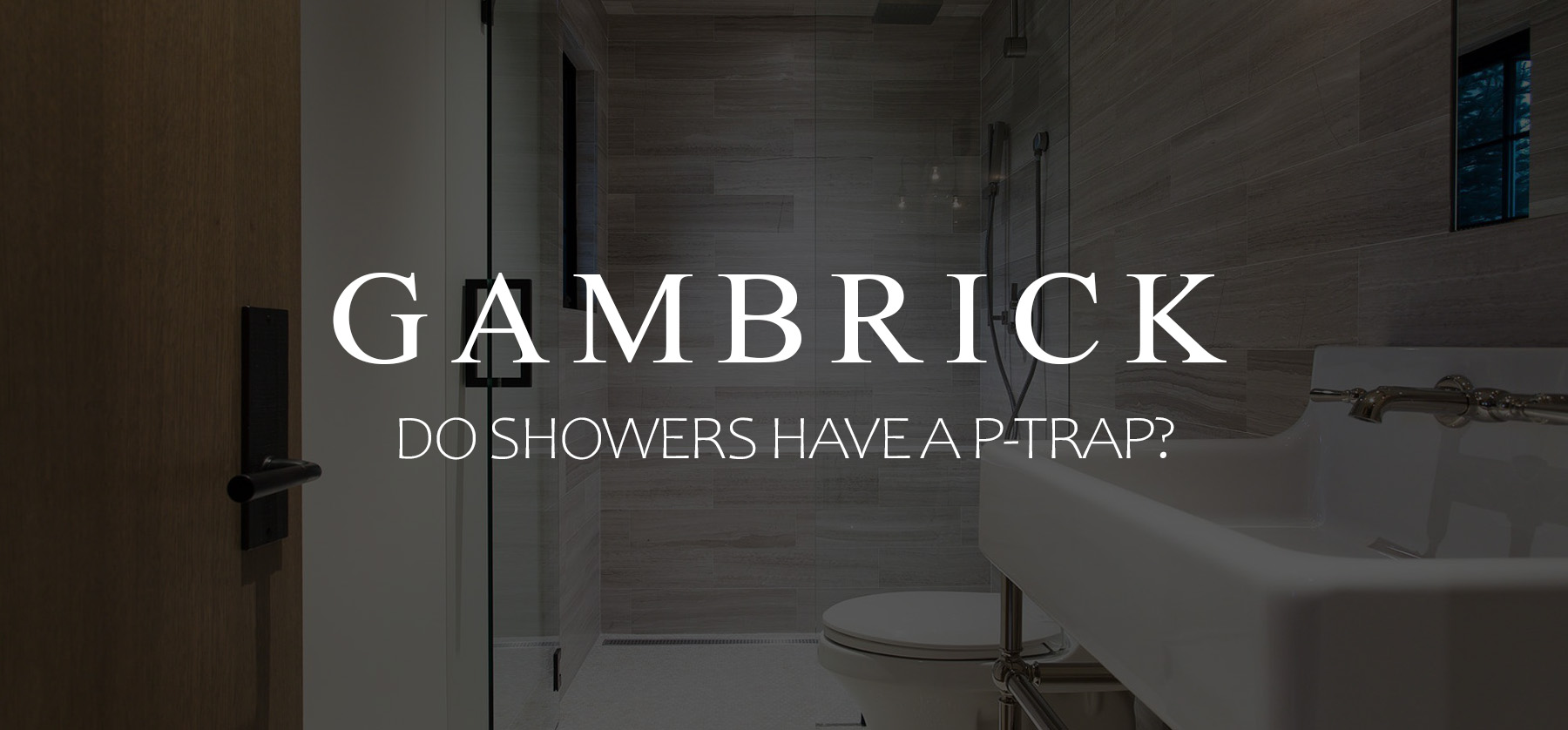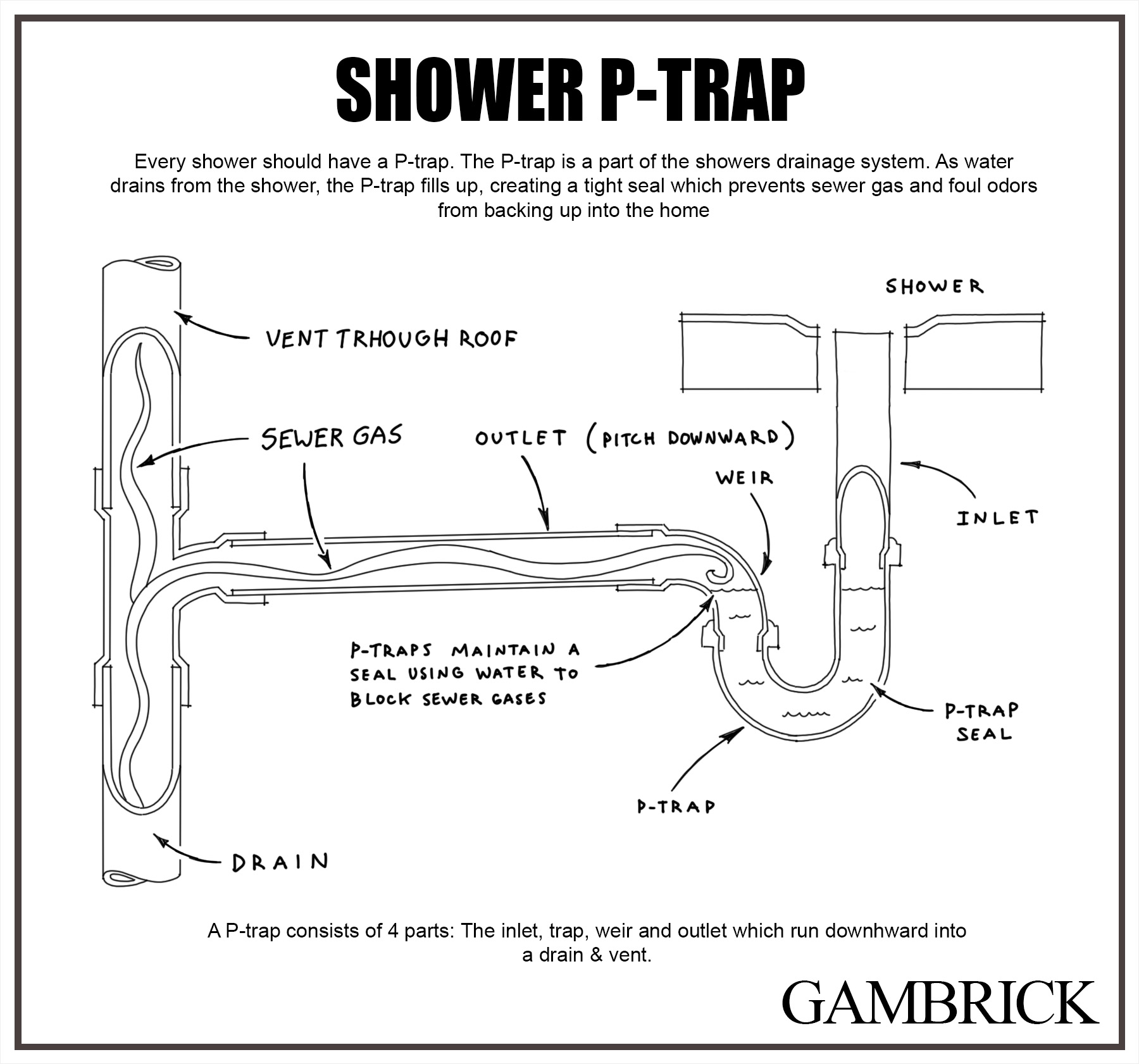Do Showers Have A P-Trap?
Every shower is required to have a p-trap. P-traps are part of a home’s plumbing and drain system. They’re called a P-trap because of their letter “P” shape and can be found under all sinks, tubs and showers. A p-trap holds just enough water to create an airtight seal which prevents sewer gas from backing up into your home. As water runs down the drain, the trap is kept full. P-traps are nice to have in a shower because they collect things that fall into the drain. This can be unwanted gunk and hair which causes a clog or a dropped wedding ring.
According to plumbing regulations, all shower drains are required to have a P-trap. This also includes all fixtures connected to a building’s main plumbing system. P-traps have been around for about 250 years as a way to keep sewer gasses and odors from backing up into the house.
P-traps contain a u-shaped bend that filters water as it enters the drain. The trap is connected to the shower with a J-bend on one end which exits into your drainage system. The J-bend is the section of the p-trap that resembles the letter “J”.
The bend in the p-trap collects water in the curve, creating a water seal at the weir. This prevents sewer gasses and odor from entering the home. The weir is the upper bend of the p-trap in which water would start to spill into the wall tube.
With every use of the shower, new water flushes through the p-trap, replacing the old water in the curve with fresh water.
Most shower and floor drain p-traps are built out of 2 inch PVC pipe. If your shower drains slowly, you may have a clog just below the floor drain plate or in the p-trap.
What Does A Shower P-Trap Do?
According to plumbing regulations, all shower drains are required to have a p-trap. P-traps are curved pipes installed under the shower drain which look like the letter “P”. The curve in the pipe which creates the “P” shape fills with water creating a tight seal. The seal is what keeps sewer gasses and foul odors from backing up into the home through the drain.
A p-trap is an essential part of your shower drain. It helps direct water out of the house and prevents gasses from backing up into the bathroom. They also collect small objects that fall down the drain like rings and other jewelry.
Shower p-traps are a common area that gets clogged. Gunk and hair can accumulate inside the trap which blocks the flow of water. If this happens, the best way to fix it is with a snake.
A p-trap is composed of a few main parts: the tailpiece, j-bend, weir and horizontal wall tube. Many also include a clean-out at the bottom of the bend.
- The tailpiece, also called an inlet, is where water enter at the drain.
- Next is the j-bend which is what creates the letter “P” shape. This is where water collects to seal the drain against sewer gas backup. And it’s also where clogs and things that fall down the drain collect.
- Many p-traps also include a clean-out plug at the bottom of the j-bend. This comes in handy if you get a clog or are looking for a lost item.
- A weir is a small bend which connects the j-bend to the wall tube.
- Finally there’s the wall tube which runs horizontally to the home’s main drain line.
Where Is The P-Trap In A Shower?
The shower p-trap should be located directly below the shower drain. The tailpiece, or inlet, part of the p-trap connects directly to the shower floor drain. It’s important to position the p-trap as close to the floor drain as possible because it helps prevent odors. The p-trap wall tube runs horizontally under the shower to the nearest main drain line.
How To Clean A Shower P-Trap
Cleaning a shower p-trap is hard to do than a sink because it’s not as accessible. But it’s important to do periodically to keep gunk and hair from building up inside the trap. The best way to clean a p-trap is with a plumbers snake or some pipe cleaner like Drano.
First, remove the shower floor drain cover and use a bristled brush with some cleanser to clean the drain area just under the plate. This is a common place where gunk and hair can start to build up.
Next, insert a plumbers snake down the drain and into the p-trap. The trap is located just under the drain so you don’t have to snake far. Push the snake in and out and spin it to get hair built up along the sides. Then pull the snake out and clean it off. Re-insert the snake and repeat until you’re not bring up any more hair or gunk.
Finally, try a drain cleaner like Drano. Pour the recommended amount down the drain and flush with warm water when necessary. A good quality drain cleaner can remove gunk and hair that won’t come up from the snake. But don’t over use them or you could damage the pipes.
How To Replace A Shower P-Trap
The main problems homeowners have with their shower p-trap is hair and gunk building up in the pipe. If it gets so bad that snaking and cleaners won’t fix it, you may have to replace the trap.
Replacing a shower p-trap is more difficult than a sink because it’s so hard to get to. You can either do it from inside the shower or below. But either way you’ve got some demo to do.
Replacing a shower p-trap from inside the shower is a big job if the shower is built on a membrane, hot mopped floor, shower base or fiberglass. In order to get to the trap you need to go through the waterproofing layer which destroys the shower floor and tile. This means the entire waterproofed sub-floor has to be ripped out and redone to get to the trap. Unless your shower is built on a slab I recommend replacing the p-trap from underneath.
If you can get to the underside of the shower, it’s very easy to replace a p-trap. Simply demo some drywall to expose the trap. Once exposed, cut the p-trap pipe out from the floor drain to the horizontal wall pipe with a Sawzall and replace it all with a new trap. Then repair the drywall.
Replacing a p-trap from inside the shower essentially destroys the entire shower floor and some of the walls. This is because you have to waterproof the entire floor and at least 6 inches up the walls after you replace the trap. The only way to avoid redoing the entire shower is if you can find an exact tile match.
I recommend replacing a shower p-trap from the bottom whenever possible.
How Do I Know If My Shower Drain Has A P-Trap?
A p-trap fills up with water when you turn the shower on. This creates a seal which prevents sewer gasses and odors from backing up into the house. If your shower has a a p-trap then some water will be left inside the pipe after you turn off the shower. Take a flashlight and look down the drain, if you see water then you have a trap. If you can’t see far enough down the drain, insert a snake into the drain. If it hits water within a foot or two then you have a trap.
How Do You Clean A Shower P-Trap?
You can clean a shower p-trap with a commercial cleanser like Drano or a natural alternative like baking soda and vinegar. To make a baking soda and vinegar solution: mix ½ cup of baking soda with ½ cup of vinegar and 1/2 cup of warm water. Pour it through the drain then flush with warm water. This helps unclog and clean the drain. Then use white vinegar to scrub and clean the drain floor plate. Use a plumbers snake to remove hard stuck gunk and hair.
Why Does My Shower Smell Like Sewer?
If your shower drain stinks like a sewer, it’s because the P-trap isn’t preventing sewer gases from backing up into your bathroom. The first thing you should do is clean the trap. Use a plumbers snake to get out as much hard stuck hair and gunk as you can. Then use a commercial cleanser like Drano or an all natural cleaner like baking soda and vinegar. Repeat the snake and cleanser as needed. If a thorough cleaning doesn’t prevent the smell, you probably need a new trap.
A shower p-trap holds water which prevents sewer gasses and foul odors from backing up into the bathroom. If the trap isn’t creating a seal like it should, gasses will pass through the trap and into the bathroom. If this happens, you either have a dirty trap or need a replacement.
Summary: Do Showers Have A P-Trap?
Every shower is required to have a p-trap. P-traps are part of a home’s plumbing and drain system. They’re called a P-trap because of their letter “P” shape and can be found under all sinks, tubs and showers. A p-trap holds just enough water to create an airtight seal which prevents sewer gas from backing up into your home. As water runs down the drain, the trap is kept full. P-traps are nice to have in a shower because they collect things that fall into the drain. This can be unwanted gunk and hair which causes a clog or a dropped wedding ring.
According to plumbing regulations, all shower drains are required to have a P-trap. This also includes all fixtures connected to a building’s main plumbing system. P-traps have been around for about 250 years as a way to keep sewer gasses and odors from backing up into the house.
P-traps contain a u-shaped bend that filters water as it enters the drain. The trap is connected to the shower with a J-bend on one end which exits into your drainage system. The J-bend is the section of the p-trap that resembles the letter “J”.
The bend in the p-trap collects water in the curve, creating a water seal at the weir. This prevents sewer gasses and odor from entering the home. The weir is the upper bend of the p-trap in which water would start to spill into the wall tube.
With every use of the shower, new water flushes through the p-trap, replacing the old water in the curve with fresh water.
If you have any questions or comments e-mail us any time.






















